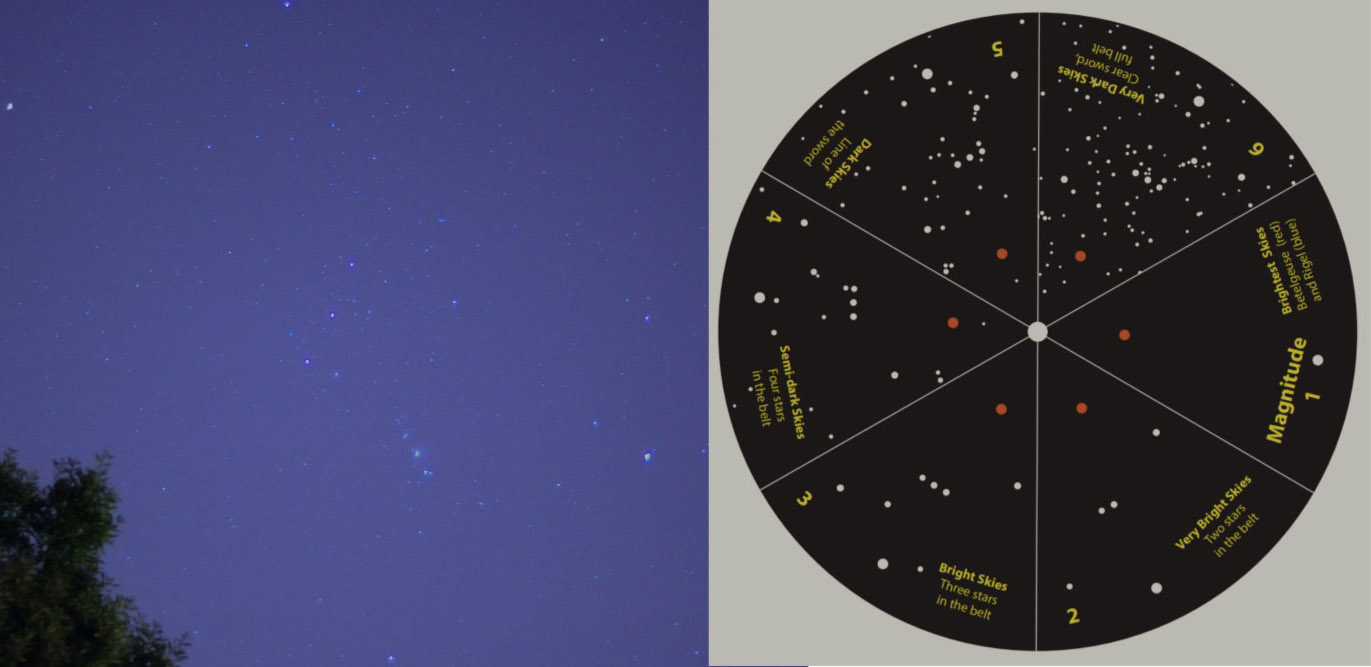
Check Your Sky’s Quality with Orion!
January 2021 :
Have you ever wondered how many stars you can see at night? From a perfect dark sky location, free from any light pollution, a person with excellent vision may observe a few thousand stars in the sky at one time! Sadly, most people don’t enjoy pristine dark skies – and knowing your sky’s brightness will help you navigate the night sky.
The brightness of planets and stars is measured in terms of apparent magnitude, or how bright they appear from Earth. Most visible stars range in brightness from 1st to 6th magnitude, with the lower number being brighter. A star at magnitude 1 appears 100 times brighter than a star at magnitude 6. A few stars and planets shine even brighter than first magnitude, like brilliant Sirius at -1.46 magnitude, or Venus, which can shine brighter than -4 magnitude! Very bright planets and stars can still be seen from bright cities with lots of light pollution. Given perfect skies, an observer may be able to see stars as dim as 6.5 magnitude, but such fantastic conditions are very rare; in much of the world, human-made light pollution drastically limits what people can see at night.
Your sky’s limiting magnitude is, simply enough, the measure of the dimmest stars you can see when looking straight up. So, if the dimmest star you can see from your backyard is magnitude 5, then your limiting magnitude is 5. Easy, right? But why would you want to know your limiting magnitude? It can help you plan your observing! For example, if you have a bright sky and your limiting magnitude is at 3, watching a meteor shower or looking for dimmer stars and objects may be a wasted effort. But if your sky is dark and the limit is 5, you should be able to see meteors and the Milky Way. Knowing this figure can help you measure light pollution in your area and determine if it’s getting better or worse over time. And regardless of location, be it backyard, balcony, or dark sky park, light pollution is a concern to all stargazers!
How do you figure out the limiting magnitude in your area? While you can use smartphone apps or dedicated devices like a Sky Quality Meter, you can also use your own eyes and charts of bright constellations! The Night Sky Network offers a free printable Dark Sky Wheel, featuring the stars of Orion on one side and Scorpius on the other, here: bit.ly/darkskywheel. Each wheel contains six “wedges” showing the stars of the constellation, limited from 1-6 magnitude. Find the wedge containing the faintest stars you can see from your area; you now know your limiting magnitude! For maximum accuracy, use the wheel when the constellation is high in the sky well after sunset. Compare the difference when the Moon is at full phase, versus new. Before you start, let your eyes adjust for twenty minutes to ensure your night vision is at its best. A red light can help preserve your night vision while comparing stars in the printout.
Did you have fun? Contribute to science with monthly observing programs from Globe at Night’s website (globeatnight.org), and check out the latest NASA’s science on the stars you can - and can’t - see, at nasa.gov.
This article is distributed by NASA Night Sky Network. The Night Sky Network program supports astronomy clubs across the USA dedicated to astronomy outreach. Visit nightsky.jpl.nasa.gov to find local clubs, events, and more!
The Dark Sky Wheel, showing the constellation Orion at six different limiting magnitudes (right), and a photo of Orion (left). What is the limiting magnitude of the photo? For most observing locations, the Orion side works best on evenings from January-March, and the Scorpius side from June-August.



